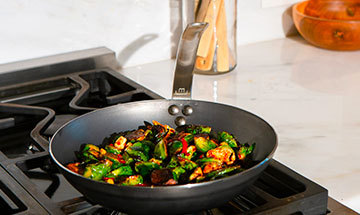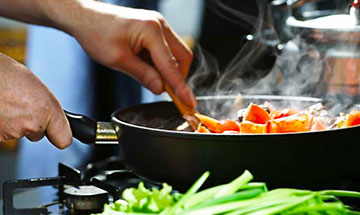Contents
When you want to upgrade your cookware, the one common issue you’ll definitely face will be different types of pans; they are made of various materials, e.g. cast iron, stainless steel, best carbon steel pan, etc. But not only that! You have to choose a model depending on your cooking methods: skillet pan vs frying pan.
Our team of experts created this article to help you to understand all the nuances, advantages and disadvantages of the most common types of pans. When you realize the difference between frying pans and skillets, your cooking will definitely improve. Keep reading!
What Is A Frying Pan

A frying pan has a wide, flat base and round flared sides. Mainly, such models are on the lighter side, however, it depends on the material the item is made of; they come without a lid. You can use a spatula for flipping the food easily thanks to sloped sides. To make it short, pan cooking is quick cooking.
What Is A Skillet
A skillet is a kind of frying pan with wide, round bottom and high, flared and a bit curved sides, making it deeper. Some of them have 2 handles a main, long handle and a helper one because skillets tend to be heavy. So, when you are coking and moving the food around, it’ll be more convenient with 2 handles. Mainly, skillet cooking is quite a long procedure with much liquid and steam. A skillet can make the best saute pan.
- [Stone-Derived Coating] This 10-inch red frying pan uses Whit-ford granite paint without PFTE & APEO, and uses a professional casting process to create a standard frying pan shape; the interior of the frying pan has good thermal conductivity. Aluminum alloy layer, scratch-resistant layer, thickened layer, the weight will not be too heavy or too light, to meet your daily cooking needs. Please note that when using this frying pan for cooking, do not always choose the high-temperature mode.
- [Upgraded Non-Stick Frying Pan & Easy to Clean] Koch systeme cs nonstick skillets provide you a pleasant cooking moment. With little oil for a healthy diet, the frying pan can help you solve stick and difficult to clear problems. Only need a soft sponge or dishcloth, you can clear oil stain easily. You’d better not use a steel ball to clean the pot, it will destroy the surface of the frying pan.
- [Uniform Heating System] The interior of this stone pan is made of durable heavy-duty die-cast aluminum with a magnetized base, which can be used with a fast heat exchange induction furnace. Excellent and long-lasting non-stick coating, anti-warpage, uniform heating underside, and patented Thermo Spot technology. When using it, pay attention to heating the bottom of the frying pan for tens of seconds to cook faster and better!
- [Ergnonmic Bakelite Handle] The bakelite handles are comfortable to grip and stay cool while cooking. The height of this 10in nonstick frying pans is 3.34ines. Suitable for use on –Induction, electric, gas, ceramic, and halogen cookers. Please put this skillet in a cool place after cleaning. In addition, Oven and Dishwasher are not applicable.
- [Valuable Investment & After-Sales Service] Koch systeme cs will provide you with intimate after-sales service, we are confident that our frying pan is manufactured under strict quality standards. If you meet any problems, don't hesitate to contact our 24/7 online customer service which will reply to you as soon as possible to help with your worries. Totally no-risk purchase!
Difference Between Skillet And Frying Pan
Now when we’ve found out the definitions of each cookware, we are ready to take a closer look at their differences, pros, and cons.
Frying Pans
So, what are frying pans good for?

- Mainly, the benefits of cast iron pan lie in its design – shallow, relatively thin with sloped sides. Thanks to it, you’ll spread the food evenly and cook fast.
- Your meals will be flavorful thanks to the fact that you cook them fast. Such a method seals the flavor, and it doesn’t escape.
- This model is a versatile cookware, it means that you’ll prepare lots of meals in it. A good frypan can even make the best paella pan.
However, there are some drawbacks if compared to skillets:
- Cooking on a frypan requires all your attention. The process is fast and you can’t walk away and leave it for a few minutes. Otherwise, the food might become overcooked or burnt.
- If you cook at high temperatures, it increases the chances of burning food.
- Slow cooking is impossible in a frypan, unlike a skillet.
Skillets
What about skillet? Is it worse or better than a frypan? Let’s find out!
- The first benefit is that skillets have relatively thick and heavy construction, it means that they provide excellent heat retention and you can cook your food slowly under the lid.
- A lot of skillets are oven-safe so that you can start cooking on the stovetop and finish it in the oven. It’s very convenient – there’s no need to transfer the food from the pan to another cookware. Customers ask “How do I know if my skillet is oven safe?” You must know what material your skillet is made of; e.g. cast iron is safe to put into the oven.
Are there any drawbacks? Not so many!
- Unlike a frypan, skillet, as well as saute pan, is heavy. That’s why it must have 2 handles for more convenient use.
- It’s inconvenient to perform quick cooking in a skillet, it’s too massive for, let’s say, fried eggs or whatever like that. Besides, you won’t be able to use a spatula to flip or stir the food.
Now you know the advantages of cast iron skillets and frying pans. Which is better? None! They are both excellent and much-needed cookware in every kitchen because skillets and frypans serve different purposes.
When To Cook With A Frying Pan

Unlike skillets or saute pans, frypans have lighter weight, making them easy to shake; their round and sloped sides help redistribute food well on the bottom. You’ll stir and flip your dish easily thanks to the wide opening. A frying pan is a good choice if you want to cook quickly, something like an omelet, mushrooms, onions, etc.
When To Cook With A Skillet Pan
Skillets are very versatile, as well as saute pans, you can cook lots of dishes with them as they hold liquids. So, what is a cast iron skillet used for? Use your skillet to make sauces, braise, poach, sear and pan-fry (if you don’t need to flip ingredients often). It is meant for large and long cooking. If the meal requires much liquid to be prepared and not lots of stirring, a skillet will do great.

Knowing the differences and how to use a skillet and frying pan, it’s easier to make the right choice. However, we, at mykitchenadvisor.com, do recommend to equip the kitchen with both tools as they carry out different tasks. If you need stir-fries or pan-to-plate fares, it’s better to use a frypan. While skillet or saute pan is ideal for long cooking with much liquid.







